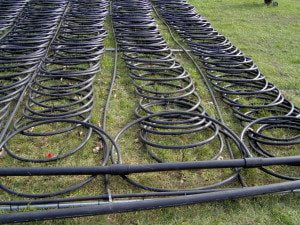

Energy
What to Expect with Ground Source Heat Pump Installation
Ground source heat pumps (GSHP) provide low grade heat absorbed from the ground. These units are excellent for both domestic and commercial buildings. Your installation company can provide you with all the details you need to know before the unit is installed.
In general, most will be buried in a horizontal space. When installed with boreholes, the GSHP unit can be positioned further down underground which means it can provide more heat.
These units have become extremely popular in the UK in recent times. This is thought to be due to the fact that many people want to do what they can to make use of green energy sources. Also, the government offers several incentives for installing ground source heat pumps, so many people are happy to take advantage of these financial benefits.
Heat pumps will undergo different stages in order to ensure that they provide heat in a feasible manner. Your heat pump installation company will take care that all of the stages of installation are performed properly. The heat will generate though a system of refrigerated vapor that undergoes a compression cycle. This cycle transforms the low grade heat from underground into a temperature high enough to comfortably heat a home or commercial building.
Choosing a Site for the GSHP Installation
You may have an idea of where you would like to have the unit installed. However, it is up to the professional installation company to examine the outdoor area to make sure the ground conditions are ideal for installation.
There are loops or holes that will need to be set up for boring. The installer will take into account the size of your home or the building itself and will determined the heating needs for it. This will help determine how the unit gets installed. In some places, underfloor heating may be recommended.
Even though GSHPs are suitable for different buildings, the buildings may need to undergo retrofitting in order to be properly set up for the heating system. If this is necessary for your home, you should consider the advantages of getting underground heat versus keeping your existing system. This can be a much greater way to avoid Co2 emissions and can be a healthier alternative of heat. The cost of retrofitting will be paid for in the savings you get for the use of the GSHP.
The Heat Pump and its Installation
The heat pump installer will advise you of how much the property may need to undergo prior to the GSHP being installed. The property may undergo a degree of disruption, but only to the point at which it is absolutely necessary to install the pump properly. Excavation levels will vary, depending on the property.
In addition to factoring in the cost of the installation, you have to think about the base cost of the pump. There are different price points for vertical loop pumps or horizontal loop pumps. Vertical pumps cost more due to the fact that a borehole must be created as well.
Planning Permission of the Ground Source Heat Pump
With domestic heat pump installation you must follow the laws as they pertain to the project by Permitted Development. Small changes may be made without getting planning permission, but always verify this before beginning the installation. Commercial heat pumps will need to get permission from the Local Planning Authority.


 Environment10 months ago
Environment10 months agoAre Polymer Banknotes: an Eco-Friendly Trend or a Groundswell?

 Environment11 months ago
Environment11 months agoEco-Friendly Home Improvements: Top 7 Upgrades for 2025

 Features9 months ago
Features9 months agoEco-Friendly Cryptocurrencies: Sustainable Investment Choices

 Features10 months ago
Features10 months agoEco-Friendly Crypto Traders Must Find the Right Exchange


















